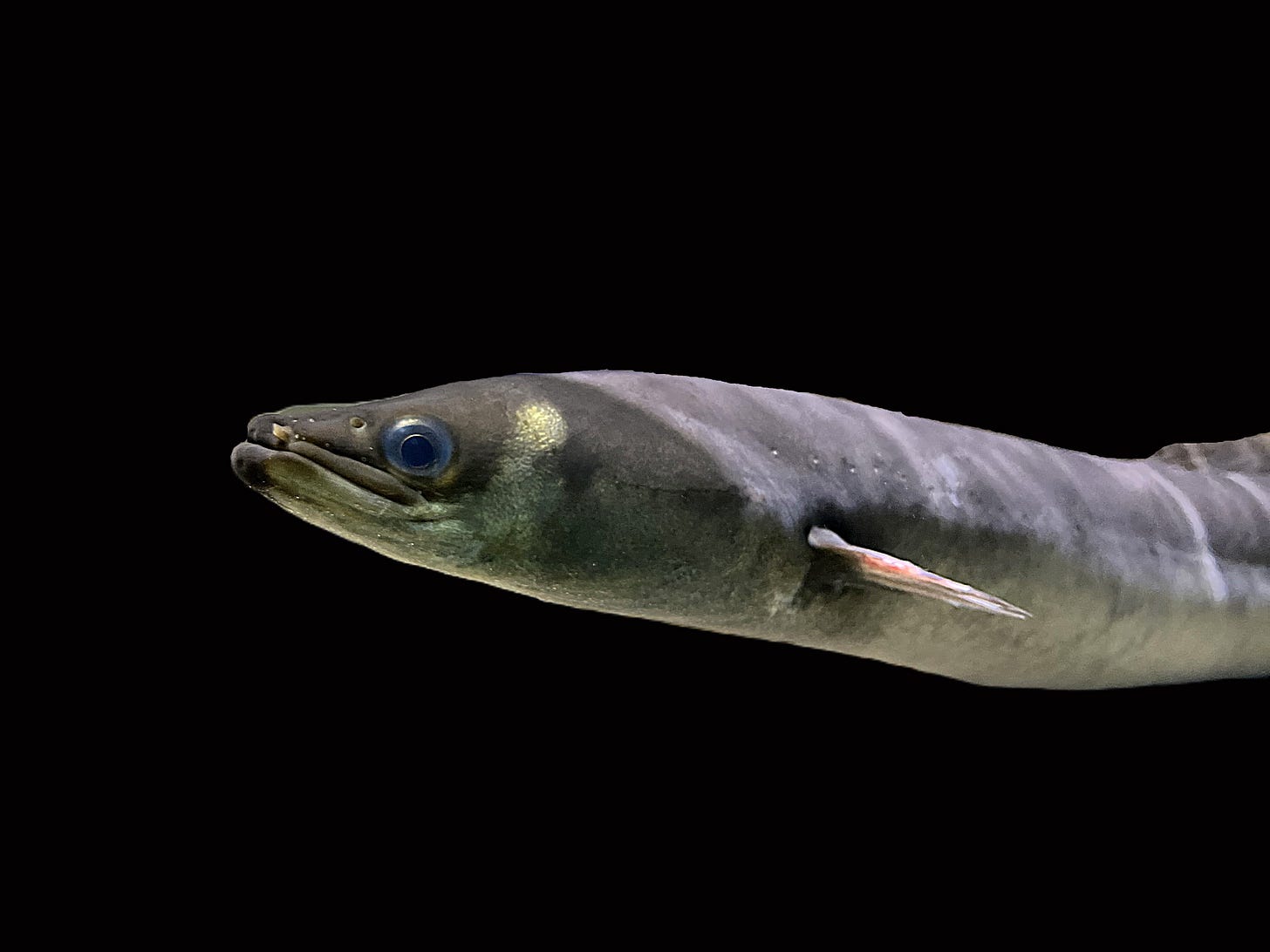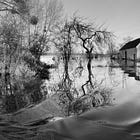Long, slimy, and oft forgotten
How to revive a once abundant source of protein while returning life to Somerset rivers
At Muchelney Abbey – a 7th century monastery not far outside Langport – eel was often if not usually on the menu. More than that, the slender fish constituted a part of everyday life throughout centuries of the abbey’s history. It was even used as currency, and at other local monasteries too – tenants of Glastonbury Abbey in at least the 12th century, for example, paid their landlord monks a rental stipend of 14,000 eels a year.
On hearing about this huge abundance of eels in this part of Somerset, and remembering her grandfather catching up to 200 of them in one sitting, one night Vanessa Becker-Hughes set out with a bait and line.
“I was out for six hours,” she tells the WFJ. “And I only caught one.”
Vanessa has since made it her mission to “get local people start thinking about eel” – a creature we know relatively little about (continually confounding zoologists and ecologists, even) that formerly made up half of UK rivers’ biomass, but since the 1950s has declined by up to 99%. Vanessa’s endeavors have coalesced into the Somerset Eel Recovery Project (SERP) – the aims of which could be more achievable, she says, if eel made its way back onto the British menu. “If we can start eating them again, you bring in an intense focus on it.”
On this, Vanessa is more qualified than most. Her grandfather would store his caught eels in the bathtub, then “skin them, cut them up, and put them in the freezer,” she says. “When we wanted to eat them, my mother would fry them in butter and we'd have them with toast.” At this point I’m reminded of Quo Vadis’ almost iconic smoked eel sandwich – proof to many at least that this is not an insipid, slimy protein only eaten in pie and mash shops for when you felt brave enough. Paradoxically, perhaps eels could be saved if we ate them. Or, as is the case with salmon, perhaps not – similar to eels, salmon would have migrated up and down the rivers of Somerset once upon a time, but despite Britain’s raging appetite for the fish, wild salmon is now pretty much entirely off the menu, and its farmed, decrepit, and disease-ridden cousins are much preferred instead.
"I love eel. Sometimes I think it is my favourite fish. It is delicate, but rich; it falls neatly from the bone; grilled to golden brown and flecked with dark crustiness from a charcoal fire, it makes the best of all picnic food; stewed in red wine, cushioned with onions and mushrooms, bordered with triangles of fresh bread, it is the meal for cold nights in autumn; smoked and cut into elegant fillets, it starts a wedding feast or a Christmas Eve dinner with style and confidence."
– Jane Grigson, ‘English Food’, 1974
Eating eel is also not a problem in other parts of the world. Far from it – they’re one of if not the most trafficked creatures on the planet, worth up to an annual $2.5 billion on the black market particularly in certain parts of East Asia, while also prized in innumerable other cultures such as those of Central Europe, Eastern Europe, and Scandinavia.
So what about Britain? Overfishing, pumping stations (which Vanessa says “turns them to sushi”), and waterway ‘improvements’ have led to its borderline disappearance from UK rivers, and therefore – it is thought – our diets. The accessibility of other proteins has also had something to do with it, as has the notion it’s virtually impossible to farm, market, and sell eel as a commodity product because we know so little about its life cycle.
There’s a dreadful irony here – the proliferation of commodity animal protein has come at the expense of free, abundant protein that once fuelled local communities for centuries. A case in point: due in part to the levels of pollution in the River Wye caused by run-off from nearby intensive chicken farms, eels have become almost non-existent there.
Conventional farming has had its effects in Somerset too – the continual draining of the Levels in order to relieve the area of water, and therefore habitable and farmable, has not done eels any favors. “They like to hide under big boldery stones,” Vanessa says. “So when the rivers are dredged, that’s another kind of habitat they don’t have access to.”
That said, the biggest reason the European Eel has become critically endangered – and therefore SERP’s greatest tangible focus – is the hundreds of flood barriers, locks, weirs, culverts, and other man-made obstacles up and down the Parrett, Severn, and Brue rivers. After one of the natural world’s most epic migrations (spanning three years and 6,000 miles – something we’ve only known about since 2022) from the Sargasso Sea just east of the US, eels arrive to the Bristol Channel as juvenile ‘glass’ eels a few centimetres in length. Over the next few decades, “Their main purpose is to find fresh water to put weight on,” says Vanessa. “So they will be trying to eat like mad, and growing by up to a few feet long, before going all the way back to spawn in the Sargasso. But if there’s a barrier in the way, they can’t do that.”
As of quite recently, SERP’s efforts have helped in persuading and inspiring river custodians to install eel passes, enabling them to get up and around significant obstacles otherwise hampering their direction of travel. And where smaller barriers present themselves, there’s a solution for those too. “We met with the drainage board this year and we taught them how to make straw ropes, which is a very traditional method of helping the baby eels migrate,” says Vanessa. “They’ve been monitoring the success of these at key places on the Parrett River.”

Ultimately, an improvement in eel numbers should help the overall health of a river. They’re considered a missing ingredient of river ecosystems, as they’re a potential major food source for fish, otters, and wading birds like herons and bitterns. They will also eat just about anything alive or dead – fly larvae, crustaceans, animal carcasses included.
Ecology, however, isn’t SERP’s main impetus. Rather, that falls to “history” and “tradition” – words they’ve used to describe why we should be preserving the eel. Often, that narrative starts in the classroom, as SERP last year brought 60 eel tanks to classrooms across Somerset, helping children learn about and look after elvers (young eels) before releasing them into local rivers. A crowdfunder to extend the project and bring eels to other community centres this year is ongoing.
It would be naive to think the general neglect of the eel, especially with regards to it as a food source, is not in some way owed to the perception of it falling into the broad category of ‘revolting creatures’. But, as a schoolteacher at Abbot’s Way School in Meare said to The Times during SERP’s ‘Eels into classrooms’ project, “We can’t just look after cuddly animals.” Indeed we can’t, which is why Vanessa encourages anyone who spots an eel in a Somerset river to let her know about it. And any landowners to “upgrade” their weirs.
Anyway, since eels are at the moment protected in the UK, we can’t actually fish them out a local river and eat them. But that’s not to say even those 7th century monks, who did largely live off the land, can’t still teach us something about how to recover an association with the eel and the ecosystems they rely on.
Read next >
They don't fish (the Bristol Channel) like this anymore
Venturing too far out of Bridgewater Bay at low tide isn’t best advised. The mudflats there are at times like quicksand and, though it’s possible to walk miles from the shore, to do so would take you to a featureless landscape that in fog or low light can have you misremembering which way’s the Bristol Channel and which way’s dry land. By the time you’d…







